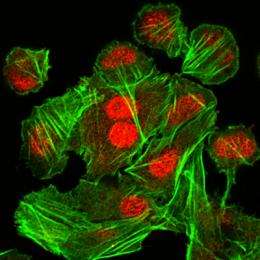Researchers publish paper on CHO-K1 cell genome sequencing

The Chinese Hamster Ovary (CHO) cell is one of the most preferred hosts used to manufacture therapeutic proteins -- genes that are added to "cell factories" to produce proteins that are later turned into medicines.
Protein therapeutics need a clean and controlled environment to grow in, and the CHO cell, which is approved by the U.S. Food and Drug Administration, provides this. In addition, CHO cells are able to produce complex, human-like proteins for the treatment of disease. But what has eluded scientists until now is precisely how and why the CHO cell behaves as it does.
“Scientists are constantly working on ways to make as much of a protein in a host cell as possible, in the best, safest, and the most economical way possible,” says Kelvin Lee, director of the Delaware Biotechnology Institute and Gore Professor of Chemical Engineering at the University of Delaware.
The growth and behavior of the host cell can affect the protein being made, so figuring out how cells work at the genetic level will allow scientists to better manufacture these medicines to treat a wide range of human diseases, such as Alzheimer’s and cancer.
The father of all CHO cells, CHO-K1, has been sequenced and analyzed by a team of domestic and international partners including UD, Johns Hopkins University, Stanford University, BGI-Shenzhen, GT Life Sciences, and many more.
“Knowing the complete sequence of a genome shows us all the capabilities and limitations of a cell. It helps us understand metabolism and protein production pathways of cells, amongst other important factors,” says Stephanie Hammond, postdoctoral fellow in UD's Department of Chemical Engineering. “We now have a foundation for understanding how the cell works.”
In a paper published in the journal Nature Biotechnology on July 31, Lee and collaborators discuss the first ever genome sequencing of the CHO-K1 cell, providing the groundwork for further investigation into the cell’s behavior. The portion of the research done at UD was funded in part by the University, as well as the Delaware IDeA Network of Biomedical Research Excellence (INBRE) grant from the National Institutes of Health. The data collection was performed at the UD Sequencing and Genotyping Core Facility run by Bruce Kingham.
Now that a baseline for the CHO-K1 genome has been established, Lee and colleagues felt it was important to maximize the impact and dissemination of this data. Toward this end, UD scientists and collaborators from Johns Hopkins, BOKU University in Vienna, and a number of industrial partners and government agencies will establish an online database at UD to allow the international biotechnology community to store and update information about CHO cells.
By taking a cue from social networking sites, academic, industrial and government scientists will be able to participate in ongoing efforts to improve gene annotations, contribute new data and foster new collaborations.
“There is a $77 billion global market for protein therapeutics, and 70 percent of them are made in CHO cells,” says Lee. “This kind of collaboration and exploration will translate into better manufactured medicines that are affordable, while simultaneously stimulating economic growth. We’re excited to be a part of this effort and particularly excited that many biotechnology companies have agreed to support the CHOgenome.org website.”
Provided by University of Delaware


















